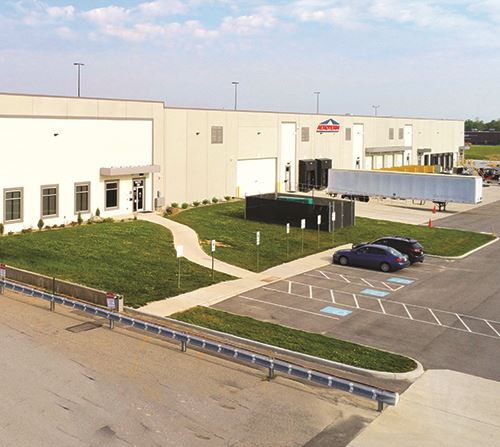Cincinnati/Northern Kentucky International Airport (CVG) suffered a significant financial blow a little more than a decade ago when Delta Air Lines dropped the airport as one of its primary hubs. But in true make-lemonade-out-of-lemons fashion, airport leadership charted a new course, based on a simple premise: A multi-legged stool is more stable than one with a single leg.
Cincinnati/Northern Kentucky International Airport (CVG) suffered a significant financial blow a little more than a decade ago when Delta Air Lines dropped the airport as one of its primary hubs. But in true make-lemonade-out-of-lemons fashion, airport leadership charted a new course, based on a simple premise: A multi-legged stool is more stable than one with a single leg.
 “We needed to diversify our revenue stream,” explains Candace McGraw, who was hired as CVG’s chief executive officer in 2011. “We had all of our eggs in one basket, so we had to assess what things we had going for us that we could use to buoy our financial situation.”
“We needed to diversify our revenue stream,” explains Candace McGraw, who was hired as CVG’s chief executive officer in 2011. “We had all of our eggs in one basket, so we had to assess what things we had going for us that we could use to buoy our financial situation.”
That comprehensive re-assessment led to an impressive renaissance, with McGraw and the Kenton County Airport Board transforming CVG into a powerhouse cargo hub. After five consecutive years of record-breaking cargo growth, CVG is now the seventh-largest cargo airport in North America. By 2026, tenants and carriers will have invested more than $2 billion in cargo-related projects there since about 2016.
|
Projects: Cargo Facilities Location: Cincinnati/Northern Kentucky Int’l Airport 2020 Cargo Volume: 1.5 million tons Ranking: 7th-largest cargo airport in North America Cargo Carriers: 9 2020 Passenger Volume: Nearly 3.62 million passengers Primary Cargo Tenants: DHL; Amazon Air; FedEx Private Investment in Cargo Facilities: $2+ billion from roughly 2016 through 2022 Airport Costs: About $5 million for infrastructure improvements Manholes/Catch Basins/Drain Trench Covers: EJ Primary Developers: Aeroterm; Dermody Properties; Paul Hemmer Companies; Lynxs Group; Van Trust Real Estate LLC Annual Regional Economic Impact: $6.8 billion Direct/Indirect Employment Impact: more than 47,000 jobs Key Benefits: Revenue growth; diversified business base; profitable use of ample vacant land; spin-off economic developments that create more jobs & regional growth |
Last year, CVG handled 1.5 million tons of cargo, a 13.4%% increase compared to 2019. And it’s off to a strong start for 2021, with cargo shipments for the first two months totaling 252,509 tons, a 38% jump compared to the same period last year. From a longer-term perspective, airport officials report that cargo shipments from March 2016 to March 2021 rose fully 84%.
Soon, the airport will be home to two global air cargo hubs—one already in operation by incumbent DHL and another scheduled to open later this year by Amazon Air. DHL employs about 4,600 people at its cargo facility, one of its three global “super hubs,” and has invested $380 million in facilities on the south side of the CVG campus.
Amazon’s global cargo hub represents one facet of about $1.5 billion the giant company plans to invest at CVG through 2026. The 3-mile-long building will be the company’s largest cargo facility in the United States, occupying a 650-acre parcel on the south side of the airport. Amazon also has an option to lease another 450 acres for future expansion, McGraw notes.
Notably, the flurry of development at CVG was funded by various tenant companies, without any airport or government subsidies. The only major cost incurred by CVG during the last five or so years was about $5 million in infrastructure improvements, such as utility work, paid for with general airport revenue.
Location, Land & Infrastructure
Several things stood out when airport officials evaluated their assets and business opportunities about a decade ago. One was location: The airport stands at an opportune central intersection of the global supply chain network.
But perhaps the most valuable asset was available land—about 4,000 undeveloped acres, primarily on the south and west sides of the airport and conveniently located adjacent to the airfield.
The airport also has four runways (three parallel runways and one crosswind), well-maintained infrastructure, easy access to major highways (CVG is girdled on three sides by two interstate freeways) and a large local labor pool.
McGraw points out another less tangible, but equally valuable, asset: a business-oriented mindset. “We move at the speed of business,” she explains. “We run the airport like the business it is. Private companies want to move ahead quickly on things when they see the need, so I feel our job is to enable them to move as quickly as possible.
“Our board of directors is made up of wise business leaders, and they allow us to operate like a business,” she adds. Case in point: The Amazon deal was approved in just two board meetings.
The airport’s nimble operating philosophy wins it points with prospective and current tenants. “We really believe in CVG,” says Alexi Lachambre, vice president of development and investments at Aeroterm, an airport real estate developer that recently completed its first project at CVG. “It has a great location, includes some of the largest players in the cargo industry and offers great infrastructure. And the airport authority is very committed to a cargo-growth strategy.
 “CVG is a very good business partner for us, and it’s an airport where we want to have more exposure,” he adds. “We believe the market and demand will keep growing there.”
“CVG is a very good business partner for us, and it’s an airport where we want to have more exposure,” he adds. “We believe the market and demand will keep growing there.”
Jeff Billingsley, vice president and general manager of DHL’s hub at CVG, notes that the airport’s location is ideal, because it’s within a one-hour flight of 60% of the U.S. population.
“CVG is not only ideal from a weather perspective, but the tri-state area of Ohio, Kentucky and Indiana has been a great place to find talented, dependable and hard-working people that can support our operation,” Billingsley said in a prepared statement. “CVG and the Kenton County Airport Board have been great partners for DHL, and we look forward to continued growth and expansion over the coming years.”
Domino Effect
DHL was an early catalyst for CVG’s strategic shift. The cargo company was already operating a facility there when it approached airport officials in the late 1990s about expanding its operations.
Now, DHL operates 114 daily arrivals and departures, occupies 194 acres of land, manages 6.4 million square feet of ramp area, utilizes 67 parking gates, employs 4,800 people, clears 3.8 million import shipments per month and handles an average 295,701 pieces of cargo per night, according to the latest report from CVG.
“We worked hand in glove with DHL to make their expansion happen,” says McGraw. “And as cargo operations grew, so did the need for aircraft maintenance; and we had land to accommodate that, too. So we attracted a variety of different tenants both within the fence and outside the fence to keep more revenue flowing in on a regular basis.”
The momentum accelerated even more in 2016, when Amazon approached CVG about building its cargo facility. The move was as unexpected as it was game-changing, McGraw notes.
“We were just trying to diversify our revenue base,” she says. “Who could’ve foreseen Amazon wanting to build a cargo hub here? It was like landing the great white whale.”
The influx of cargo operations naturally enhances overall airport revenue. Although McGraw says it’s difficult to pinpoint exactly how much revenue has grown over the years due to landing fees, ground leases, etc., she describes the uptick as substantial.
“The increases in cargo shipments help the passenger carriers grow, too, because the increase in landing-weight fees reduces their landing fees,” she adds. “It’s a very synergistic relationship.”

Development Begets Development
Amazon broke ground on its facility in 2019. And just as a major initiative in a city can spur further investments around it, other developers soon wanted in at CVG, too.
In 2020, airport real estate developer Lynxs Group completed a 103,000-square-foot, $19 million maintenance hangar for FEAM Aero that is designed to handle wide-body cargo planes. The new facility is located just across a taxi lane from the Amazon development and the DHL facility.
On the north side of the airport, Aeroterm recently finished a single-story, 54,000-square-foot terminal support building. The facility can accommodate another 100,000 square feet of expansion, which Aeroterm plans to build out in stages.
According to the airport, FedEx will occupy part of the LEED-certified building. Other portions will be used for ground service operations and as a common-use cargo facility.

“We also built 75,000 square feet of ramps with charging stations for electric vehicles,” Lachambre adds. “The airport is pushing for carbon-neutrality, which includes replacing older ground service cargo equipment with electric-powered vehicles.”
The new Aeroterm building enabled CVG to move several ground-service operators from a functionally obsolete building that will be demolished to make way for an aviation and corporate hangar development. In addition, two former terminal facilities were cleared to make way for a new rental car facility, located adjacent to the main terminal and scheduled to open in fall 2021.
The existing rental car service centers will be developed into cargo support functions after the rental car facility is operational.
The More, the Merrier
From 2016 to 2021, other developers have built about six additional facilities at CVG. Tenants include Bosch Automotive, Wayfair, DB Schenker and GE Aviation. Atlas Air and its subsidiaries, which are major contractors for DHL and Amazon, recently established a $34 million operations center adjacent to the airport to support existing business and future growth.
McGraw foresees that development trend continuing.
“Our goal is to capitalize on all this cargo growth for the greater good of the airport and the community,” she remarks. A five-year strategic plan details what McGraw calls “hangar row,” located on approximately 85 acres of land located just south of the east-west crosswind runway and north of the Amazon cargo center.
“This development could include maintenance hangars, avionic shops—possibly even a facility to train airplane mechanics,” she says. “We could build a whole economy around us by leveraging this cargo opportunity.
“It’s not just about planes coming in and out, but building an ecosystem around it to benefit the community,” McGraw qualifies. “Right now, it’s just a vision. But as part of our five-year plan, we’ll will it into existence.”
CVG wants to attract businesses that make products companies like DHL and Amazon ship. More specifically, it wants to identify and attract companies that will be producing what McGraw calls “goods of the future.” She plans to draw those companies to the airport or the region, where they can manufacture goods and benefit from real-time delivery supported by CVG and its tenants.
More Than Just an Airport
McGraw’s interest in developing a mini-economy built around CVG underscores her belief that airports should serve as catalysts for economic development in their respective cities and regions.
From all indications, CVG is doing its part. A study compiled by two local universities estimated the airport’s regional economic impact in 2018 at $6.8 billion. Furthermore, the airport supports approximately 47,000 jobs, directly and indirectly, including more than 14,000 badged employees at the airport. Beyond nine cargo carriers, CVG has 11 passenger airlines and tour operators.
But the economic impact of its cargo facility expansions reaches far beyond the airport. Take EJ, for instance, a company based in Michigan that makes covers for infrastructure such as drainage trenches, manholes and catch basins.
 EJ recently supplied 16,092 feet of trench drainage grates, more than 400 manholes of various sizes and 300 catch basins for sewer lines at CVG, reports Lee Veldboom, the company’s technical sales engineering manager.
EJ recently supplied 16,092 feet of trench drainage grates, more than 400 manholes of various sizes and 300 catch basins for sewer lines at CVG, reports Lee Veldboom, the company’s technical sales engineering manager.
“That’s a very significant volume of products,” says Veldboom. “We offer a dedicated product line for airports because of the load rating requirements. Some airplanes weigh upwards of 700,000 pounds, so you need components designed to handle that kind of weight.”
Ambitious Vision
So what’s the takeaway for other airports, based on CVG’s experience with cargo operations?
“I tell my colleagues to look at the assets they have and figure out if there’s something they can leverage,” McGraw advises. “We’re blessed with 7,500 acres of land, but each airport has to dig in and find out if there is something it can do to avoid putting all its eggs in one basket.
“We benefited a lot from being a Delta hub,” she continues. “But without it, we’ve emerged as a much more financially stable airport in the long run, because we’ve diversified our carrier base and now have different lines of businesses that didn’t exist before.

“In fact, we fared okay during the pandemic because we largely recession-proofed our business.”
In the next five or so years, McGraw foresees transforming the region’s business climate while elevating and redefining the role the airport can play in that development.
For example, consider the airport’s Strategic Workforce Collaborative, a program established in 2018 that brings together local educational institutions and more than 70 airport employers. Its primary goal is to help create meaningful employment opportunities and training programs to develop job-ready workers to fill them.
One result is the CVG Job Portal, which serves as a one-stop shop for candidates interested in working for or at the airport.
“I know our vision sounds bold,” McGraw acknowledges. “People always ask me, ‘Are you sure you want to say that publicly?’ But if you don’t try, you’ll never get where you want to go. And we have a great team in place here at CVG.
“The time is ripe to seize these opportunities,” she concludes. “We can’t afford to waste them.”


 facts&figures
facts&figures

